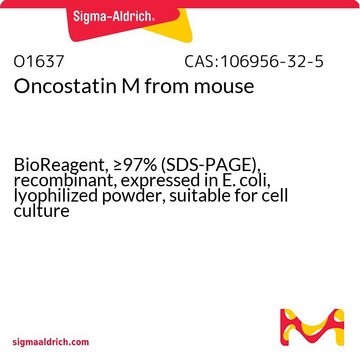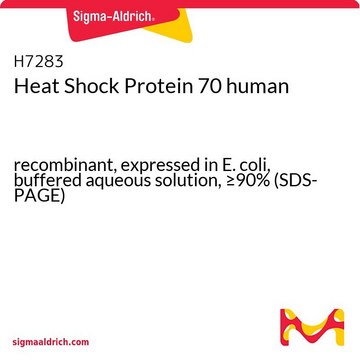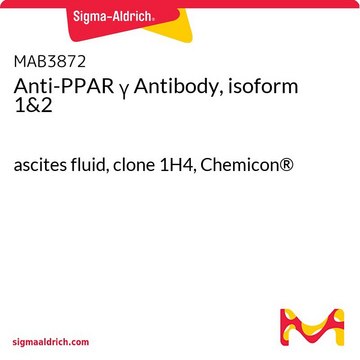SRP3250
Oncostatin-M from rat
recombinant, expressed in E. coli, ≥98% (SDS-PAGE), ≥98% (HPLC), suitable for cell culture
Sinonimo/i:
OSM
Autenticatiper visualizzare i prezzi riservati alla tua organizzazione & contrattuali
About This Item
Codice UNSPSC:
12352202
NACRES:
NA.32
Prodotti consigliati
Origine biologica
rat
Ricombinante
expressed in E. coli
Saggio
≥98% (HPLC)
≥98% (SDS-PAGE)
Stato
lyophilized
PM
24.4 kDa
Confezionamento
pkg of 10 μg
tecniche
cell culture | mammalian: suitable
Impurezze
<0.1 EU/μg endotoxin, tested
Colore
white to off-white
N° accesso UniProt
Condizioni di spedizione
wet ice
Temperatura di conservazione
−20°C
Informazioni sul gene
rat ... OSM(289747)
Descrizione generale
OSM (oncostatin M) is a polypeptide growth factor that belongs to the interleukin-6 cytokine family that includes interleukin-6, interleukin-11, leukemia inhibitory factor, ciliary neurotrophic factor, cardiotrophin-1, and novel neutrophin-1/B-cell-stimulating factor-3. In rats, this protein shows high expression in the late fetal and neonatal testis. It is also expressed at lower levels in the maturing and adult testis. It is also thought to be expressed in Leydig cells in developing testis.
Recombinant rat Oncostatin M is a 24.4kDa protein, containing 215 amino acid residues.
Recombinant rat Oncostatin M is a 24.4kDa protein, containing 215 amino acid residues.
Azioni biochim/fisiol
OSM (oncostatin M) functions as a ligand for two high affinity heterodimer receptors that share the signal transducing receptor gp130 (glycoprotein). The two receptors are- type I OSM receptor which is a dimer of the gp130 transducing receptor and the LIF (leukocyte inhibitory factor) receptor β-subunit, and the type II OSM receptor which contains a dimer of gp130 and the OSM receptor β-subunit. OSM is produced by neonatal Sertoli cells, where it induces Sertoli cell and gonocyte proliferation. It is responsible for the induction of spermatogenesis, and negates the effect of luteinizing hormone (LH) on Leydig cell progenitor formation, thus, acting as a regulator for this process. Study in rat shows that this protein stimulates the differentiation of OC15-5 (oval cells) into hepatocytes, and therefore, is thought to be key in liver regeneration by promoting oval cell differentiation into hepatocytes.
Sequenza
MKRGCSSSSP KLLSQLKSQA NITGNTASLL EPYILHQNLN TLTLRAACTE HPVAFPSEDM LRQLSKPDFL STVHATLGRV WHQLGAFRQQ FPKIQDFPEL ERARQNIQGI RNNVYCMARL LHPPLEIPEP TQADSGTSRP TTTAPGIFQI KIDSCRFLWG YHRFMGSVGR VFEEWGDGSR RSRRHSPLWA WLKGDHRIRP SRSSQSAMLR SLVPR
Stato fisico
Lyophilized with no additives.
Ricostituzione
Centrifuge the vial prior to opening. Reconstitute in water to a concentration of 0.1-1.0 mg/ml. Do not vortex. This solution can be stored at 2-8°C for up to 1 week. For extended storage, it is recommended to further dilute in a buffer containing a carrier protein (example 0.1% BSA) and store in working aliquots at -20°C to -80°C.
Codice della classe di stoccaggio
11 - Combustible Solids
Classe di pericolosità dell'acqua (WGK)
WGK 3
Punto d’infiammabilità (°F)
Not applicable
Punto d’infiammabilità (°C)
Not applicable
Scegli una delle versioni più recenti:
Certificati d'analisi (COA)
Lot/Batch Number
Non trovi la versione di tuo interesse?
Se hai bisogno di una versione specifica, puoi cercare il certificato tramite il numero di lotto.
Possiedi già questo prodotto?
I documenti relativi ai prodotti acquistati recentemente sono disponibili nell’Archivio dei documenti.
Oncostatin-M inhibits luteinizing hormone stimulated Leydig cell progenitor formation in vitro.
Teerds KJ et al
Reproductive Biology and Endocrinology, 5, 43-43 (2007)
Oncostatin M inhibits proliferation of rat oval cells, OC15-5, inducing differentiation into hepatocytes.
Okaya A et al
The American Journal of Pathology, 166(3), 709-719 (2005)
Bruce, A.G., et al.
Cytokine Reference, 585-598 (2001)
T M Rose et al.
Proceedings of the National Academy of Sciences of the United States of America, 88(19), 8641-8645 (1991-10-01)
Oncostatin M (OSM), a glycoprotein of Mr approximately 28,000 produced by activated monocyte and T-lymphocyte cell lines, was previously identified by its ability to inhibit the growth of cells from melanoma and other solid tumors. We have detected significant similarities
Zhen Wang et al.
Molecular medicine reports, 19(3), 1529-1542 (2018-12-29)
Psoriasis is a chronic inflammatory skin disease. Keratinocytes (KCs), as skin‑specific cells, serve an important role in the immunopathogenesis of psoriasis. In the present study, transcriptome data derived from psoriasis‑like KCs were used together with the reported transcriptome data from
Il team dei nostri ricercatori vanta grande esperienza in tutte le aree della ricerca quali Life Science, scienza dei materiali, sintesi chimica, cromatografia, discipline analitiche, ecc..
Contatta l'Assistenza Tecnica.








